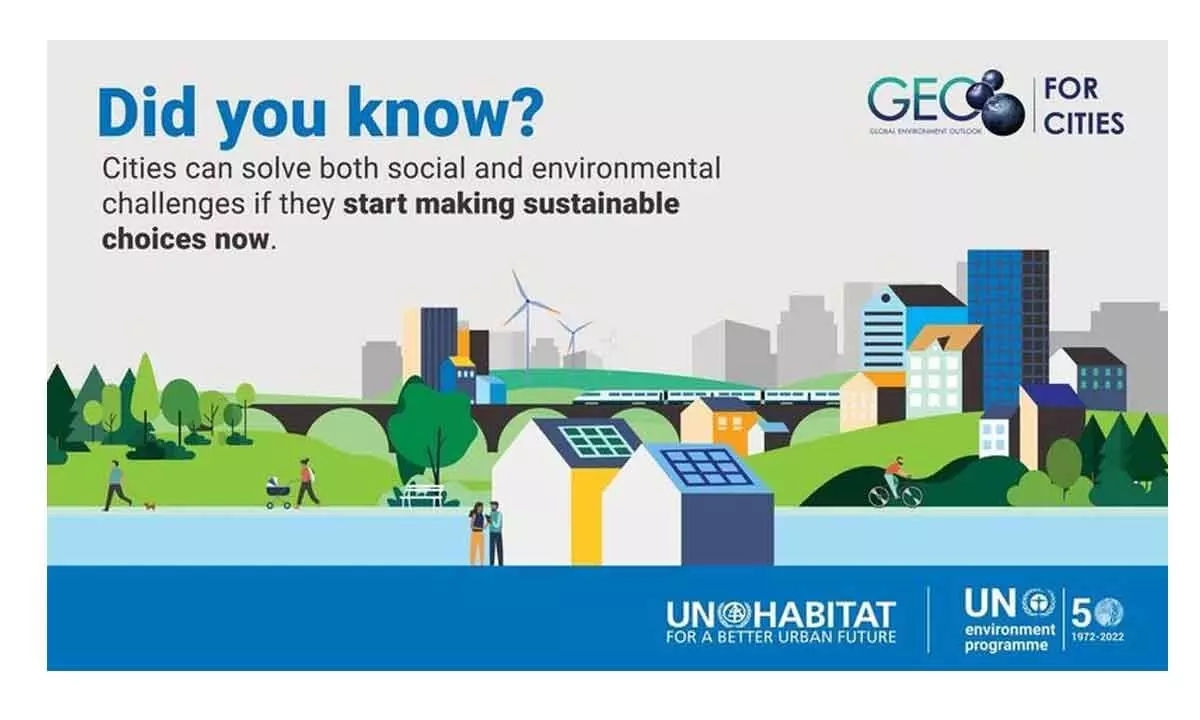Making our cities environmental powerhouses is within us
Cities contribute 75% of the world’s greenhouse gas emissions
image for illustrative purpose

Our cities are in trouble, but we can transform them into environmental powerhouses with science, technology and innovation. Cities, once seen as concrete consumers, can become vibrant producers, turning waste into resources, energy into opportunity, and pollution into life
Over half of the world’s population lives in cities, according to the UN, which also projects that the figure will rise to 68% by 2050. And the way we use our cities is also changing rapidly, spurred on by our increasing digital connectivity, as well as concern for the future if we can’t effectively reduce our greenhouse gas emissions.
Cities continue to attract people looking for jobs and the benefits of a thriving and diverse urban lifestyle. But bringing so many people together in a small space has its downsides, something which the pandemic has vividly brought to the fore.
Housing shortages, overcrowding, pollution and lack of infrastructure add to human health issues and strangle social mobility. At the same time, cities are major contributors to global greenhouse gas emissions, producing over 75% of the world’s emissions, according to estimates from the UN’s Environment Programme.
However, not all cities are created equal. Research published in ‘Frontiers in Sustainable Cities’ calculates that over 50% of those greenhouse gas emissions come from just 25 urban centres. Other cities are already embracing innovations in housing, transport and waste management to create a healthier, fairer and more environmentally-friendly future for their citizens.
Fighting climate change and making our cities carbon-neutral is understandably a priority for many of us. But the sustainable cities of the future also need to consider the needs of their human inhabitants.
Cities are economic powerhouses, creating jobs and contributing around 60% of the world’s GDP, according to the UN. But many people live in urban poverty.
The International Institute for Environment and Development estimates that around a billion people live in informal settlements – sometimes known as shantytowns.
Singapore’s plan includes planting a million more trees, which it estimates will sequester 78,000 tonnes of carbon dioxide, as well as improving the city’s air quality and increasing its resilience to heat. Food security is also a major focus. Singapore’s Green Plan includes the goal of meeting 30% of the city’s nutritional requirements from locally grown food by 2030. On a small island, this is a challenging but necessary aim. The city believes technology will play a vital role in increasing its food resilience and plans to create indoor, multi-storey farms powered by LEDs to boost production.
Our cities are in trouble, but we can transform them into environmental powerhouses with science, technology and innovation. Imagine living in cities with clean air, green spaces and efficient energy - this is the future we can create if we work together.
Cities, once seen as concrete consumers, can become vibrant producers, turning waste into resources, energy into opportunity, and pollution into life.
Technology translates these insights into action. Sensors woven into the fabric of our cities gather whispers of the wind, whispers of waste, whispers of potential.
AI, the tireless conductor, orchestrates these whispers, optimizing energy grids, routing self-driving pods, and guiding waste streams to new life. From smart homes that learn our habits and adjust accordingly, to vertical farms that coax food from rooftops, technology is weaving a web of green efficiency and resilience.
Innovation, the spark of imagination, ignites the flames of possibility. Architects dream up buildings that mimic nature's ingenuity, breathing life into barren rooftops and transforming parking lots into vibrant oases. Entrepreneurs conjure up ingenious solutions, turning trash into treasure, and abandoned lots into urban forests. Artists, the alchemists of perception, reimagine our streets as playgrounds, plazas and vibrant arteries of green, reconnecting us to the pulse of our cities and each other.
The cities are poised to continue undergoing profound transformations. Trends and challenges that have been gradually evolving in recent years will converge. As advancements in technology and science continue to deploy endless possibilities for urban planners and decision-makers, further anticipation, adaptation and coordinated solutions will be expected from cities, who will also need to discern the implications of current global tendencies, while prioritizing their citizens and the planet’s interests.
In the 2030 Agenda for Sustainable Development, countries have committed to engage in systematic follow-up and review of progress towards the goals and targets, using a set of global indicators.
While cities occupy just three per cent of earth’s land, they are the driving forces of social, economic, and environmental change. Rapid urbanization is resulting in a growing number of slum dwellers, inadequate and overburdened infrastructure and services (such as waste collection and water and sanitation systems, roads and transport), worsening air pollution, and unplanned urban sprawl.
Thus, the environment puts forward the need for critical urban infrastructure to be low-emission, resource efficient and resilient. Better urban planning that endeavours to decouple, decarbonize and detoxify cities will be crucial and result-oriented strategies

